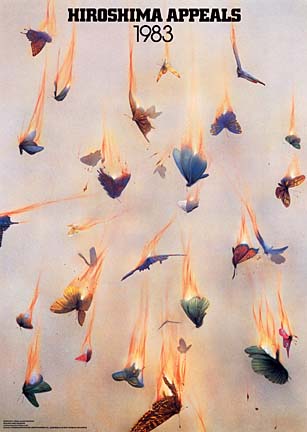

|
Made in Japan
An exhibit of 100 posters
from 1945 to 1989 showcases
Japanese designers' graphical skills
|
It wasn't hidden away on purpose. "I knew we would show it," said UH Art Gallery director and professor of art Tom Klobe, "but I knew it was something we have permanently in the department and we didn't have to show it immediately."
Pretty soon, a decade had passed, but that turns out to be an advantage, allowing viewers a better perspective of Japan's rise as a graphics powerhouse, as well as demonstrating how technology has shaped artists' approach to art-making.
The exhibition, "The Best 100 Japanese Posters 1945-89," will open Sunday at the gallery, paying tribute to an art form that continues to define our times. The poster's vibrant colors, distinct images, bold type and innovative designs have the power to deliver instant impact, a necessity given the many competing messages that scream to be heard in the short-attention-span theater of modern life.

|
As a result, posters can convey political and ideological identity or advocate a particular cause more easily than a newspaper article or book.
Exquisite, witty, arcane or brazen, posters have been recognized as an internationally acclaimed fine art form whose success depends on concept, the clarity and brevity of its presentation, and the designers' understanding of their targeted viewers. The posters in this exhibition represent milestones in the history of graphic design.
From the vantage point of the 21st century, it's evident that the artists' progress demonstrated a spirit unbowed by the events of World War II and a determination to best the West in a more civilized manner than warfare.
"When the war ended, Japan did not have technology, they did not have quality papers, but the early work was extraordinary," Klobe said. "Within a decade they became a leader. They were able to achieve things difficult for us to achieve in the West.

|
"Where the show ends, in 1989, was almost the beginning of where we changed from paste-up techniques to computer technology. It's good to show what they were able to achieve without that crutch (of digital tools)."
Klobe said he believes the earlier work shows imagination that remains unsurpassed.
"When you have a tool that can do so much for you, you don't have to work hard to achieve a gradation of color or to change a color. You pull it in, take it out; it's immediate."
For that reason, he believes the show is more likely to resonate with older individuals rather than younger ones who grew up surrounded by bold graphics and take the work for granted. Younger artists may not recognize the amount of work that went into using such old-fashioned tools as T-squares and Exacto knives.
"They won't notice the struggle that was there," Klobe said, "but that's what it was, a struggle."

|

|

Click for online
calendars and events.